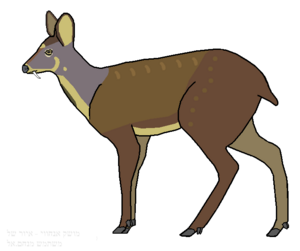Anhui musk deer facts for kids
Quick facts for kids Anhui musk deer |
|
|---|---|
 |
|
| Illustration of an Anhui musk deer in winter coat | |
| Conservation status | |
| Scientific classification | |
| Genus: |
Moschus
|
| Species: |
anhuiensis
|
The Anhui musk deer (Moschus anhuiensis) is a special kind of musk deer. It is found only in the Dabie Mountains in Anhui province, China. This animal is currently an endangered species. This means there are not many of them left in the wild. Scientists used to think it was a type of Moschus berezovskii or Moschus moschiferus. But now, they know it is its own unique species.
Contents
Where They Live
Anhui musk deer live in high mountains. Their homes are in forests with different kinds of trees. These can be pine trees, leafy trees, or a mix of both. They need thick plants and trees to hide in. This is similar to what other musk deer need.
These deer are only found in and around the Mount Dabie area. This is in the western part of Anhui Province, China. Scientists also think they might live in the Hubei Province part of Mount Dabie.
What They Look Like
The Anhui musk deer is a small animal. It is similar to the Dwarf musk deer and Siberian musk deer. Like other musk deer, it has some interesting features:
- They do not have antlers like other deer.
- Males have long canine teeth that stick out like small tusks.
- Males also have a special gland that makes a strong-smelling substance called musk.
Adult Anhui musk deer are quite small. They stand about 71 centimeters (28.3 inches) tall at their head. Their shoulder height is about 61 centimeters (24 inches). From head to tail, they are about 89 centimeters (35 inches) long. They weigh around 8 kilograms (17.6 pounds). Their fur is dark brown to gray. They have darker ears and a clear stripe on their neck and chest.
Baby Deer
During the time when they mate, male deer use their long teeth. They fight with other males to claim their space. They also use their musk to mark their territory. This helps them attract female deer.
Female Anhui musk deer can have babies when they are about one year old. They often have two babies at a time. This is different from some other musk deer, which usually have only one baby. Not much else is known about how they have babies. But it is thought to be like the Dwarf musk deer or Siberian musk deer.
Why They Are in Danger
The Anhui musk deer is listed as Endangered by the IUCN Red List. This is a list of animals that are at risk. Scientists think their numbers have dropped by half in the last 21 years. This is because of a few main reasons:
- Over-hunting: People have hunted too many of them.
- Habitat loss: Their forest homes are being destroyed.
- Less space: There are fewer places for them to live.
People hunt these deer for their musk gland. This hunting is not properly controlled. So, hunting and illegal hunting (poaching) continue.
Why Musk is Wanted
The musk from male Anhui musk deer is very valuable. It is used in perfumes and some medicines. The trade of musk is watched by an organization called CITES. However, CITES does not completely stop the trade.
Each male deer can produce about 25 grams (0.88 oz) of musk. This musk can be taken from live animals. But often, the musk gland is taken from deer that have been hunted. Musk is still wanted because 1 kilogram (2.2 pounds) can sell for a lot of money, around $45,000 USD.
Protecting Them
Since 2002, the Anhui musk deer has been on China's list of protected wildlife. It is also listed as critically endangered on the Chinese Red List. This means it is in great danger. The species is also listed under Appendix II of CITES.
Sadly, there are currently no strong rules to stop hunting or taking musk from these deer. Also, there are no special protected areas to save their homes. We do not know exactly how many Anhui musk deer are left today. The last guess was about 700-800 deer in 1985.
See Also



